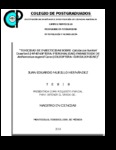| dc.contributor.author | Murillo Hernández, Juan Eduardo | |
| dc.creator | MURILLO HERNANDEZ, JUAN EDUARDO; 442520 | |
| dc.date.accessioned | 2014-06-18T21:20:27Z | |
| dc.date.available | 2014-06-18T21:20:27Z | |
| dc.date.issued | 2014 | |
| dc.identifier.uri | http://hdl.handle.net/10521/2321 | |
| dc.description | Tesis (Maestría en Ciencias, especialista en Entomología y Acarología).- Colegio de Postagraduados, 2014. | en_US |
| dc.description.abstract | Cuando no se puede evitar el uso de insecticidas es recomendable que la propuesta de manejo de sus plagas incluya el efecto de dichos insecticidas sobre los enemigos naturales (EN). En el presente estudio se evaluó el efecto de la residualidad y la toxicidad letal y subletal de los insecticidas beta-cyfluthrin, bifenazate, clorantraniliprol, flonicamid, spirotetramat y thiametoxam sobre Catolaccus hunteri, un ectoparasitoide del picudo del chile, Anthonomus eugenii. En las evaluaciones se empleó el método de contacto residual, se utilizaron discos foliares de plantas de chile como superficies de exposición. Se encontró diferencia significativa en la toxicidad letal, según la clasificación de la IOBC, thiametoxam resultó moderadamente nocivo (98% de mortalidad, categoría 3) y beta-cyfluthrin fue altamente nocivo (100% de mortalidad, categoría 4) sobre C. hunteri. Por el contrario bifenazate, clorantraniliprol, flonicamid y spirotetramat fueron prácticamente inofensivos (0% de mortalidad). Beta-cyfluthrin y thiametoxam mostraron residualidad superior a 34 días. Además, beta-cyfluthrin fue más residual que thiametoxam, con diferencias de 12 o 18 días. Respecto a la toxicidad subletal, en las variables fecundidad y número de larvas eliminadas por alimentación no se encontraron diferencias significativas respecto al testigo. La longevidad de C. hunteri disminuyó significativamente en los tratamientos bifenazate, clorantraniloprol, spirotetramat y thiametoxam en relación con el testigo. El porcentaje de vuelo de C. hunteri se redujo el 28% sólo con beta-cyfluthrin. En este trabajo se discute la relevancia de esas diferencias y la importancia de realizar bioensayos con estos insecticidas con diferentes métodos de exposición. _______________ TOXICITY OF INSECTICIDES ON Catolaccus hunteri Crawford (Hymenoptera: Pteromalidae) PASASITOID OF Anthonomus eugenii Cano (Coleoptera: Curculionidae). ABSTRACT: If insecticides are not possible to exclude in the management of some pests, it is relevant that the resposable of an IPM program could known the effects of those products on natural enemies of primary pests of its crop. The objective of the present research was to assess the residual effects, and the lethal and sublethal toxicity of beta-cyfluthrin, bifenazate, clorantraniliprol, flonicamid, spirotetramat and thiametoxam on Catolaccus hunteri, an ectoparasitoid of the pepper weevil. For all experiments the residual contact method was used. We used leaf disks of pepper plants as the surface for exposition. Significant differences were found on lethal toxicity, according to the IOBC thiametoxam was moderately harmful (98% of mortality, category 3) and beta-cyfluthrin was harmful (100% of mortality, category 4) on C. hunteri. On the other hand, bifenazate, clorantraniliprol, flonicamid and spirotetramat were harmless (0% of mortality). Beta-cyfluthrin and thiametoxam showed long residual effects, in both cases it was more than 34 days. Aditionally, beta-cyfluthrin was more residual than thiametoxam for 12 o 18 days. Talking about the sublethal effects the fecundity and the number of larvae eliminated, because of host feeding, were not different from the control. Longevity of C. hunteri disminished because of exposition to bifenazate, clorantraniloprol, spirotetramat and thiametoxam and it was shorter than the control. We only found sublethal effects on a flying test with beta-cyfluthrin, 28% of females did not fly on the 30 min observation after exposition to that product. We discussed the relevance of those differences and indicated the importance of conducting assays with the same product under different aplication methods. | en_US |
| dc.description.sponsorship | Consejo Nacional de Ciencia y Tecnología (CONACYT). | en_US |
| dc.language.iso | spa | en_US |
| dc.rights.uri | http://creativecommons.org/licenses/by-nc-nd/4.0 | |
| dc.subject | Picudo del chile | en_US |
| dc.subject | Control biológico | en_US |
| dc.subject | Enemigos naturales | en_US |
| dc.subject | Plaguicidas | en_US |
| dc.subject | Efectos subletales | en_US |
| dc.subject | Pepper weevil | en_US |
| dc.subject | Biological control | en_US |
| dc.subject | Natural enemies | en_US |
| dc.subject | Pesticides | en_US |
| dc.subject | Sublethal effects | en_US |
| dc.subject | Entomología y Acarología | en_US |
| dc.subject | Maestría | en_US |
| dc.title | Toxicidad de insecticidas sobre Catolaccus hunteri Crawford (Hymenoptera: Pteromalidae) parasitoide de Anthonomus eugenii Cano (Coleoptera: Curculionidae) | en_US |
| dc.type | Tesis | en_US |
| Tesis.contributor.advisor | Rodríguez Leyva, Esteban | |
| Tesis.contributor.advisor | Lomelí Flores, J. Refugio | |
| Tesis.contributor.advisor | Ramírez Romero, Ricardo | |
| Tesis.date.submitted | 2014 | |
| Tesis.date.accesioned | 2014-06-12 | |
| Tesis.date.available | 2014-06-18 | |
| Tesis.format.mimetype | pdf | en_US |
| Tesis.format.extent | 717 KB | en_US |
| Tesis.subject.nal | Manejo de plagas | en_US |
| Tesis.subject.nal | Pest management | en_US |
| Tesis.subject.nal | Agentes de control biológico | en_US |
| Tesis.subject.nal | Biological control agents | en_US |
| Tesis.subject.nal | Anthonomus eugenii | en_US |
| Tesis.subject.nal | Capsicum | en_US |
| Tesis.subject.nal | Catolaccus | en_US |
| Tesis.rights | Acceso abierto | en_US |
| Articulos.subject.classification | Insecticidas-Toxicología | en_US |
| dc.type.conacyt | masterThesis | |
| dc.identificator | 6 | |
| dc.contributor.director | RODRIGUEZ LEYZA, ESTEBAN; 35425 | |


